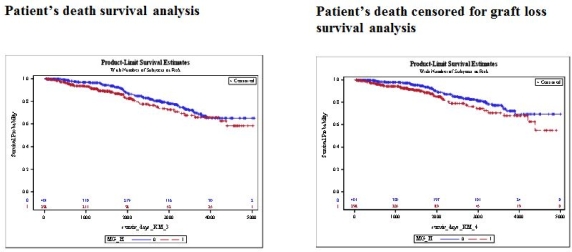Post-Transplantation Hypomagnesemia as a Predictor of Survival Among the Kidney Transplant Population.
Transplant Research Center, Brigham and women's hospital, Boston, MA.
Meeting: 2016 American Transplant Congress
Abstract number: D260
Keywords: Graft failure, Graft survival, Kidney transplantation, Outcome
Session Information
Session Name: Poster Session D: Poster Session II: Kidney Complications-Other
Session Type: Poster Session
Date: Tuesday, June 14, 2016
Session Time: 6:00pm-7:00pm
 Presentation Time: 6:00pm-7:00pm
Presentation Time: 6:00pm-7:00pm
Location: Halls C&D
We have previously shown a robust relationship between low magnesium in the first year post-transplant and better long-term kidney allograft function. Given this somewhat counterintuitive finding we studied the potential association between low magnesium post transplant and graft/patient survival.
Using our Research Data Patient Registry we conducted a retrospective single-center analysis (N=699) assessing Mg blood levels post-transplant association with both patient and allograft survival in renal transplant recipients. Patients were divided into 2 groups based on the median Mg level measured between 1-12 months post-transplant. Four survival curves (graft loss, death censored graft loss, patient's death and patient's death censored for graft loss) were estimated using the Kaplan-Meier method, and comparisons were assessed using the log-rank and the Wilcoxon tests.
Within the study population subjects had a mean age of 51±13 with 56% being male. In unadjusted Kaplan–Meier survival analyses both patient's death and patient's death censored for graft loss (Figure 1) showed a significantly higher 13-year survival rate amongst patients in the low Mg group (median Mg < 1.7 mg/dL, N=401) compared to the “high” Mg group (median Mg ≥ 1.7 mg/dL, N=298) (p=0.02 and p=0.01 respectively). In graft loss survival analysis survival rate in the low Mg group was higher compared to the high Mg group with a p value which approached significance (0.06). When we censored death from graft loss survival analysis (death with a functioning allograft) there wasn't any significant difference between the two groups (p=0.8).
Despite the known association of hypomagnesemia with both traditional and non traditional cardiovascular risk factors, its relation to NODAT, CNI nephrotoxicity and its potential to predict mortality in CKD and ESRD patients, we found that lower Mg levels post-transplant are associated with a better long term patient's survival rate in RTR. Further research is needed to understand the association between hypomagnesemia and better allograft and patient survival.
Figure 1

CITATION INFORMATION: Hod T, Patibandla B, Chandraker A. Post-Transplantation Hypomagnesemia as a Predictor of Survival Among the Kidney Transplant Population. Am J Transplant. 2016;16 (suppl 3).
To cite this abstract in AMA style:
Hod T, Patibandla B, Chandraker A. Post-Transplantation Hypomagnesemia as a Predictor of Survival Among the Kidney Transplant Population. [abstract]. Am J Transplant. 2016; 16 (suppl 3). https://atcmeetingabstracts.com/abstract/post-transplantation-hypomagnesemia-as-a-predictor-of-survival-among-the-kidney-transplant-population/. Accessed December 13, 2025.« Back to 2016 American Transplant Congress
